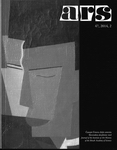
Journal ARS 47 (2014) 2
Erwin KESSLER
M. H. Maxy: Cubo-Constructivist Integralism
(Summary)
The avant-garde magazine Integral was founded in Bucharest in March 1925. It had 15 issues, ceasing to appear in April 1928. The main figure behind Integral was M. H. Maxy, avant-garde artist, professor, theorist, art manager and early art entrepreneur. Next to him, the editorial board comprised names involved, together with Maxy, in mounting the groundbreaking, primary event of the Romanian avant-garde, the First International Exhibition of the magazine Contimporanul, in November-December 1924. The paper analyzes how Integral appeared from the acutely perceived and aptly speculated misgivings behind the ecumenical show of Contimporanul. Placed on the background of such local developments, but also seen in a larger, European context offered by converging avant-garde manifestations of the time, like the First International Exhibition (1. Internationale Kunstaustellung) in Kaufhaus Tietz in Düsseldorf (1922), the publication of Die Kunstismen 1914-1924, the book issued in Switzerland, in 1925, by El Lissitzky and Hans Arp, or the Paris international exhibition from April-October 1925, the “International exhibition of modern decorative and industrial arts”, or, for short, Art Deco, the present paper shows why and how Integral had to display a move from Contimporanul’s ecumenism towards radicalism. Further on, it argues that, in both the political and aesthetic international milieu of that time Integral had to exhibit a Cubo-constructivist profile. The assumption of the present paper is that Integralism is not the product of Integral, but vice-versa: Integral was the outcome of Maxy’s prior Integralism (identified into his analyzed theoretical statements and artistic production of that time), which needed a missionary forum. However, contradicting the current art-historical perception, the present paper argues that Maxy was not the only Integralist artist at Integral. Integralism was (at least momentarily) profoundly embraced at least by few of his acolytes, as that was visible especially in the Cubo-constructivist early production of Victor Brauner and Corneliu Michailescu, and in the theoretical texts of Ion Calugaru and Mihail Cosma. Finally, Integralism is presented in its various features, ranging from its subject matter in terms of iconography to its stylistic orbiting around a (belated) analytical Cubism with Constructivist and sometimes Dadaist ideological support. The triumphant modernism advocated by Integral is ultimately perceived from its (historically) shadowy side, as it, beside a cohesive process of modernization, opened towards authoritarian discourse and practices too.